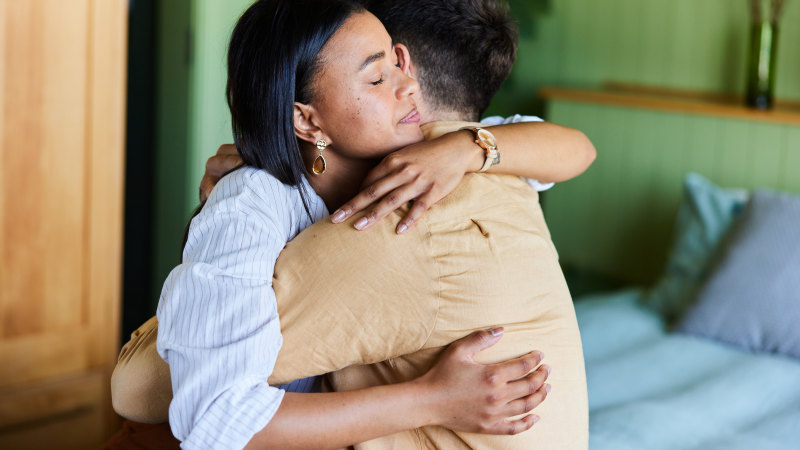O’Connor describes grieving as “a type of learning” that, over time, evolves into a newly integrated aspect of an individual’s identity. After years of living alongside a loved one, your brain needs time to adjust, to learn and relearn that the person is truly gone.
Loading
Evidence of grief can be seen on brain scans. In one study, brain imaging revealed that the greater symptoms of yearning for a loved one predicted greater activation in the nucleus accumbens, a part of the brain associated with the rewarding aspect of close relationships.
This preliminary finding emphasises the neurobiological basis of prolonged grief disorder – intense, persistent grief that interferes with daily life – and the importance of targeted psychotherapy to address it.
The lifelong trajectory of grieving requires “throwing out the map we have used to navigate our lives together with our loved one and transforming our relationship with this person who has died,” O’Connor says.
DIY grief
Younger generations have pushed back on “stages-of-grief-thinking,” says Flowers, because it implies that there is a right or wrong way to mourn loss.
Flowers, who was 21 when her mother died of lung cancer, says many dinner party attendees find they’re the first in their social circle to experience a death up close. And they’re often unable to find adequate support systems that match their need to share the intimacies of grief, such as the strangeness and loneliness of it, dating difficulties and reassessing career priorities.
COVID forced grief dinner parties to go virtual, Flowers says, but the upshot was that tables were no longer geographically constrained, which allowed more people to connect. Now, Flowers says, there are virtual tables for BIPOC grievers, those who have lost someone to suicide or experienced a pregnancy loss.
A survey of more than 350 dinner party participants found that the stronger the rapport at a table, the more likely people were to experience a “normalisation” of their grief experience, Flowers says. This, in turn, predicted a cascade of other positive benefits, including personal growth, empathy for one’s self and others, and a sense of meaning and purpose in life.
“We’ve taken that to mean: design for community, and healing will follow,” Flowers says.
Coping ‘ugly’
And, more often than not, healing does follow, says George A. Bonanno, a professor of clinical psychology at Columbia University and author of The Other Side of Sadness: What the New Science of Bereavement Tells Us About Life After Loss.
Bonanno has found that the large majority of people exposed to loss “show a trajectory of resilience”, meaning they will experience sadness and pain but over time will be able to love, work and experience joy once again.
The key to resilience, Bonanno says, is cognitive and emotional flexibility. Rather than trying to manage grief or loss all at once, start by identifying the most pressing problem and asking, “What can I do to feel better right now?”
A short-term fix might be something he describes as “coping ugly”. It could be binge-watching Grey’s Anatomy or going out one night with a friend to drink.
Most people learn to cope with grief over time. Less than 10 per cent of those suffering from the loss of a loved one follow a more “chronic trajectory,” he says, or become afflicted with “prolonged grief disorder” – when, even after many years, the bereaved person remains stuck, as if in the acute phase of grief, and appears unable to change. For this group, targeted psychotherapy and forms of cognitive behavioral therapy can offer relief.
How a new generation copes with grief
The wallop of grief can be particularly difficult for young adults, says Ann Faison, a Los Angeles-based grief educator, author and creator of the podcast Are We There Yet: Understanding Adolescent Grief.
“They are old enough, developmentally, to really feel the weight of those emotions, but they still don’t have a lot of life experience,” says Faison, who was 14 when her own mother died. “For many, it’s their first encounter with serious grief, and it’s a real shock to their system.”
Olivia Bean was 22 when her brother, Nick, just two years younger, died of a heroin and fentanyl overdose. She sought solace through the Opioid Project: Changing Perceptions through Art and Storytelling, which uses personal narrative and art-making to reframe grief. The project is a collaboration between artist Nancy Marks and Annie Brewster, a physician and assistant professor of medicine at Harvard Medical School. (I co-wrote a book with Brewster, called The Healing Power of Storytelling.)
Loading
For Bean, now 30 and a graphic designer in Plymouth, Mass., engaging in the painting project, and telling the story of her brother out loud, she says, was healing.
“I ended up loving it so much,” she says, partly because there were others her age in the group and also through the freedom art can bring. “My painting was more abstract, flowing, with lots of swirling lines, intertwined, like my relationship with my brother.”
Coping with grief can take many forms: creating or sharing music, physical pursuits such as hiking, yoga or exploring nature, volunteering or spending time with peers “who get it” can all be therapeutic.
“Whether you want it to or not, life goes on,” says Nancy Frumer Styron, a psychologist and clinical director at the Children’s Room, a bereavement centre in Arlington, Mass. “So the question becomes, how do I take this piece that has happened and integrate it into my life in a way that is part of me but doesn’t define me.”
Rachel Zimmerman is the author of Here, After: A Memoir of Love and Suicide, forthcoming in 2024.
This story originally appeared in The Washington Post.
Make the most of your health, relationships, fitness and nutrition with our Live Well newsletter. Get it in your inbox every Monday.
For all the latest Life Style News Click Here
For the latest news and updates, follow us on Google News.

